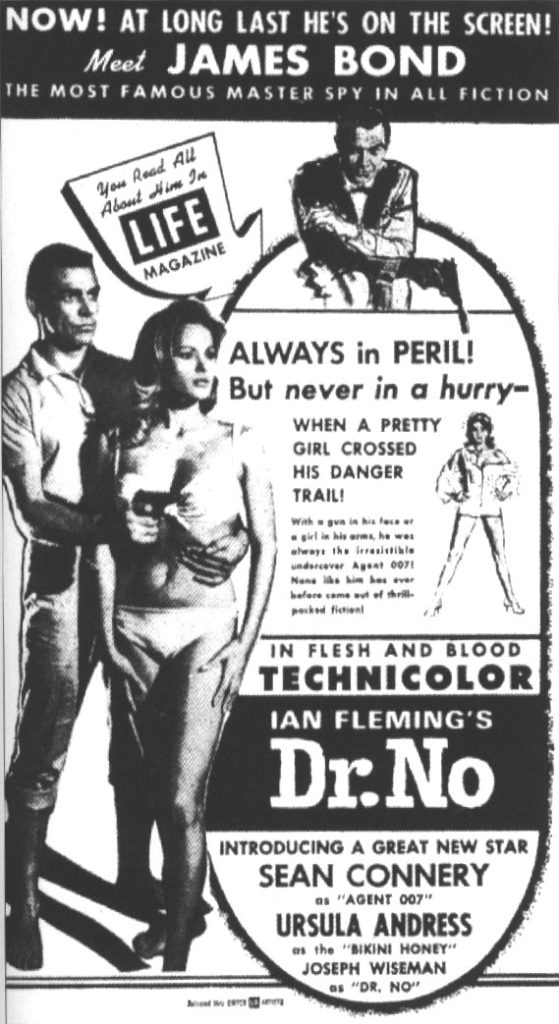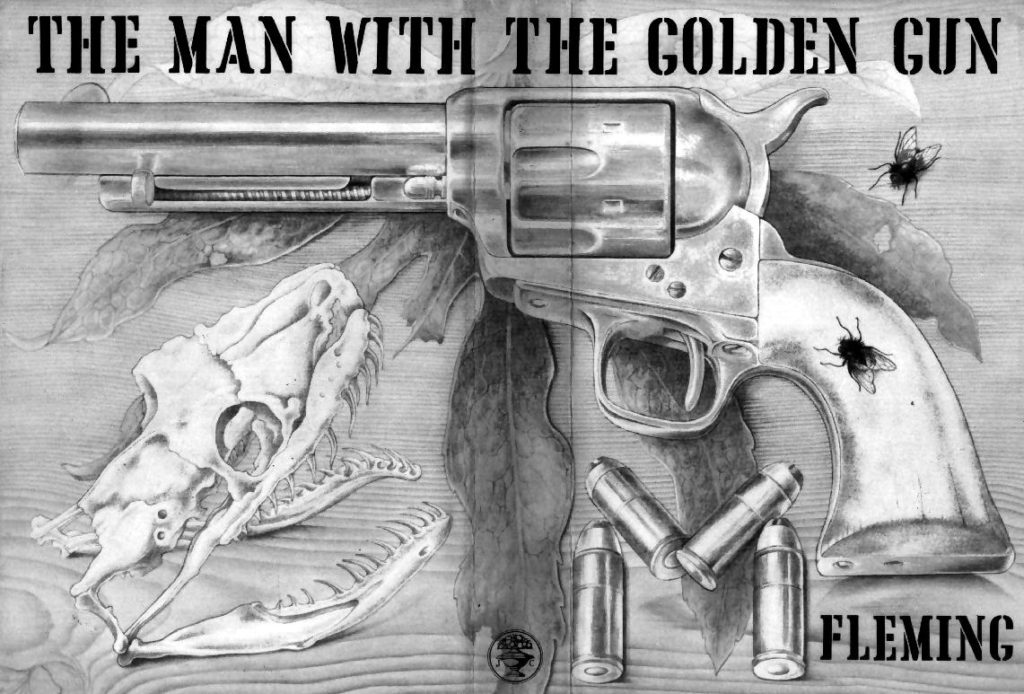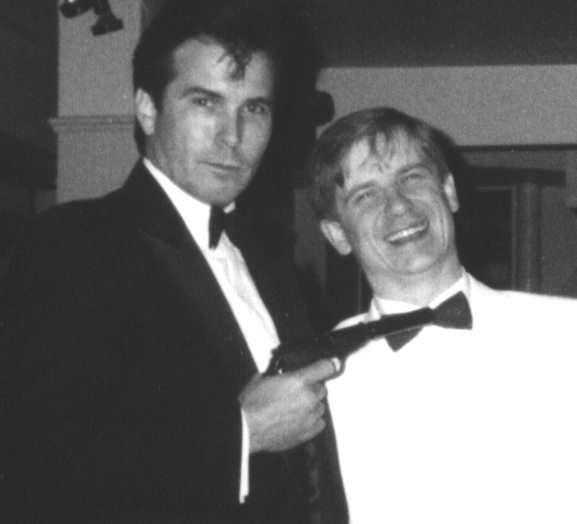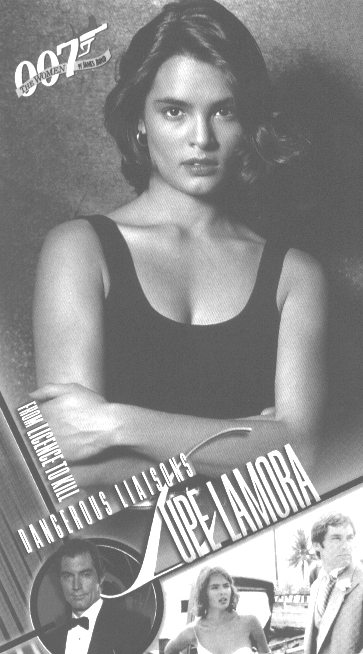Vorsprung durch Technik, Babes und Violence (as they say in MI6)
If one series sums up the TC ethos better than any other, it is James Bond: the opening chords send a tremor of anticipation down the spine, and no man can put on a white tuxedo without uttering those immortal lines, “The name’s Bond…James Bond.” 007 is the epitome of cool, the archetypal Brit – despite being played by an Australian and an Irishman, as well as a Scot and an Englishman – and is the only action hero we can offer against McClane, Ripley, Riggs and the other American franchises. It’s impressive that a series which started before I was born is still going from strength to strength, probably because they have a chameleon-like ability to change with the times, discarding the novels and taking on board the contemporary climate with regard to villains. The Russians were the obvious candidates, but refreshingly, it’s usually rogue elements rather than officially sanctioned evil. We’ve also had mad scientists, drug-dealers, renegade agents and media moguls, depending on current mores.
One friend of mine uses “Who was better, Connery or Moore?” as a pick-up line, with excellent results, because everyone knows Bond, and has an opinion. Speaking of opinions, I ploughed through ‘em all over the past couple of months, and what follows are mine. It was an interesting exercise – you could do the same with ITV’s recent series of them, though the views here are not based on the hacked versions they show. It gives a good feel for the way the series has evolved, but they still blur into one another: which ones was Jaws in, and what film had 007 driving on two wheels down a narrow alley? I won’t promise to answer these burning questions but, pausing only to pull an aqualung from the pocket of my immaculately tailored suit, let’s plunge in…

Dr. No (Terence Young) – A hundred million years ago, mankind’s nearest relative was only vaguely a mammal. And so it is with ‘Dr.No’, a Bond movie with legs, arms, and a head, but not much else. No gadgets beyond a Geiger counter, and the action is limited to Bond turning a valve and running away. Even the classic opening titles are little more than some rotoscoped dancers. On the plus side, Ursula Andress rising from the ocean sets a standard that few have matched, and Connery has a casual approach to killing which was slowly diluted in subsequent efforts. It’s surprisingly undated: even after 35 years, it’s tense and effective. A good movie, thus – just Bond in name only… B-
From Russia With Love (Terence Young) – The second film is perhaps the best illustration of how closely early Bond movies followed the books: it’s chock-full of incidents, characters and scenes taken directly from Fleming’s novel. This may be the most politically incorrect of the Bond films, with Connery screwing his way to a Soviet cypher machine, together with Lotte Lenya as lesbo-villainess Rosa Klebb, and a completely gratuitous cat-fight. This is a very prosaic movie, with a plot which is highly plausible, at least by Bond standards, capturing the cloak-and-dagger spirit of the Cold War well. It never quite gels, however, despite an abundance of marvellous set-pieces and characters, while the pacing of the climax is all wrong, with a tacked-on coda that doesn’t fit. C-
Goldfinger (Guy Hamilton) – Finally, the whole formula came together: action, baddies, babes, and a really cool car, as well as a contender for the best theme ever [although producer Saltzman called it “that fucking song”]. Even the Bondisms, previously only played with, come into full flower, and Shirley Eaton’s death, covered in gold paint, is one of the canonical images of 60’s cinema. Olympic medallist Sakata is a great evil henchmen, as the bowler-hatted Oddjob, while Q, the longest surviving character, turns up with Bond’s Aston-Martin, the dream car of every male of a certain age. Exemplifying the style running through the movie: check out the number Goldfinger’s bomb is showing when it gets defused. That, my friends, is the stuff of legend. A-
Thunderball (Terence Young) – Things regressed somewhat for Bond #4, in what now seems like a bloated exercise in excess. Remade as unofficial Bond film ‘Never Say Never Again’, by then Connery had a better hand on the character; if you’ve seen that, much of the original will seem lame. The whole “stolen nuclear weapons” scenario has been done to death since (see ‘Broken Arrow’ and ‘The Peacemaker’ for recent examples), and the lengthy underwater sequences may have been innovative at the time, but will now have you reaching for the fast-forward button. At 140 minutes, it was the longest Bond movie to that date, and it certainly seems so. D
You Only Live Twice (Lewis Gilbert) – As any fan of ‘Trainspotting’ will know, this was written by Roald Dahl. Not that it’s obvious, for the star here is really the monumental volcano set which is Blofeld’s lair. The Japanese locations are nice, but the attempts to evoke anything beyond the shallowest culture misfire, and Connery’s attempts to pass as Japanese are ludicrous. However, we get to see another classic Bond item: autogyro Little Nellie, and Donald Pleasence makes a fine Blofeld, though the other supporting characters are pretty forgettable. It’s the first Bond film to really go for a large-scale climax, with extras scurrying round like ants on a particularly incendiary ant-hill, and begins the trend towards an ever-increasing spiral of spectacle. C
The witty one-liner has long been a staple of Bond films – but it’s not just 007 who gets to deliver them. Here are ten of the best non-Bonds:
- “I think he’s attempting re-entry…” – Q, Moonraker
- “Do, Mr.Bond? I don’t expect you to do anything – I expect you to die!” – Auric Goldfinger. Goldfinger
- “Jealous husbands. Outraged chefs. Humiliated tailors – the list is endless!” – M enumerates Bond’s enemies, The Man With the Golden Gun
- “Look after Mr.Bond. See that some harm comes to him” – Hugo Drax, Moonraker
- “What’s the matter, sailor: never see a major taking a shower before?” – Sub commander, The Spy Who Loved Me. The major is Barbara Bach.
- “Once again, the pleasure was all yours” – A somewhat peeved Xenia Onatopp, Goldeneye
- “He disagreed with something that ate him” – Note on shark-chewed body of Felix Leiter, Licence to Kill
- “Ooh! The bubbles tickle my…Tchaikovsky!” – Pola Ivanova discovers the joys of jacuzzis, View to a Kill
- “Forgive me, father, for have I sinned…” “That’s putting it mildly, 007!” – Q, For Your Eyes Only
- “You always were a cunning linguist, James” – Miss Moneypenny, Tomorrow Never Dies
On Her Majesty’s Secret Service (Peter Hunt) – Despite being a relative box-office failure, OHMSS has since acquired a good rep among Bond fans. In some ways, you can see why, not least for the ending which is astonishingly downbeat and helps explains both failure and rep. The major problem remains Lazenby, who sounds the part but looks more like Roy Castle and is given an appalling dress sense, largely consisting of hideous polo-necks. You can sense the script-writers were coming up with scenes for Connery and I can’t help wondering what he’d have made of it. Against this, it’s probably the best line-up of Bond girls ever (Diana Rigg, Joanna Lumley, Anoushka Hempel), the ski stunts are great, and it’s perhaps the last to be an accurate translation of the book. C
Diamonds Are Forever (Guy Hamilton) – Poor George: not only dumped as Bond, they bring back the guy he replaced. What a sickener. His loss is our gain, as the makers respond with an upbeat cracker, packed with classic Bond-isms, thrills and excess – save, oddly, on the babe front, where 007 sticks to Jill St. John as Tiffany Case. Charles Gray gets promoted to Stroker of the White Persian, while Connery rampages around in pursuit, trashing everything from lifts to oil-rigs like a tuxedoed Godzilla. One plus is entertaining, but completely superfluous, scenes such as Tiffany’s languorous pick-up of Bond’s diamonds – add the vicious double acts of femmes fatales Bambi & Thumper, and homosexual hitmen Mr.Wint & Mr.Kidd, and you’ve got a very solid product. Look out for Cassandra Peterson, pre-Elvira and fame, as a showgirl. B

Live and Let Die (Guy Hamilton) – For the first time, a rock band and not a lounge singer did the theme, with Paul McCartney delivering a classic. Shame, then, that the film falls short; not because of Moore, who does the one-liners very well, it’s just that the villains are so inept as to be totally non-threatening. This is summed up by Rosie Carver, of the ‘Dr.Who assistant’ school (honours in “screaming” & “running away”); with allies like her and the San Monique police, who can’t drive in a straight line, what hope for Yaphet Kotto? The Tarot/voodoo backdrop is nice, and there are moments for the Bond Hall of Fame, the speedboat chase and the New Orleans “funerals” in particular. Yet these don’t gel into anything to equal the theme song. C-
The Man with the Golden Gun (Guy Hamilton) – This is really amazingly lacklustre: it takes Bond 70 minutes to get a shag, and in terms of action, virtually all you get is the odd fist-fight and two soporific chases. It seems very cheap (Christopher Lee, good as assassin Scaramanga, can muster precisely two henchmen – actually closer to one-and-a-half) and stretched; everything takes three times as long as it should. Britt Ekland is another uber-bimbo, perpetually screwing up and needing rescue, while Moore shambles from one scene to another. Despite obvious theft from the previous year’s ‘Enter the Dragon’ – the Far East setting, an evil millionaire and a hall-of-mirrors climax – two kung-fu schoolgirls and a solitary decent car stunt fall well short of what’s required for even minimal entertainment. D-
The Spy Who Loved Me (Lewis Gilbert) – Opens with one of the best pre-credit sequences (the Union Jack parachute ski-jump), albeit spoiled by truly dreadful back projection. This sets the tone for the whole film, which is grand, providing you don’t look at it too closely – the plot bears a strong resemblance to lace; lightweight and full of holes. Still, there’s good use of locations, and Jaws is one of the all-time evil sidekicks, to go alongside one of the all-time cars, the Lotus Esprit. Barbara Bach, as Soviet agent Triple X, makes a better assistant to Bond than an adversary, and things perk up notably after the first act, which largely consists of pottering round in pursuit of a microfilm. C

Moonraker (Lewis Gilbert) – The brassy Bassey theme falls well short of ‘Goldfinger’, and this is a very disappointing entry in general. The plot is no more than an excuse for product placement and exotic travel: Bond sees a packing case with a place-name on it, and hey, goes there. Good job he didn’t find a box of Mars bars. Drax may be the dumbest villain ever, revealing his plans to all and sundry at the drop of a megalomaniacal hat. There are numbing elements of slapstick, notably a chase through Venice, which don’t work, and border on parody, though there is one decent in-joke involving ‘Close Encounters’ and a pleasant amount of glass-smashing. The space sequences at the climax are pretty good, but long before you get there, you’ll have ceased to care very much. Even the return of Jaws is largely botched. D-
Never Say Never Again (Irvin Kershner) – let’s look at some facts:
- Written by the same guys who wrote Thunderball
- Starring the original James Bond
- Standard characters from all the James Bond films
- Same evil villain, determined to take over the world (or destroy it)
- Cool gadgetry and chase scenes
- Gorgeous Evil Psycho Nympho women
- Gorgeous Good Nympho women
This is a James Bond film. Why is it so hard to understand? Nobody argues over the ‘Alien’, ‘Terminator’ or ‘Hellraiser’ series, do they? No one cares who marketed, produced, directed, or wrote them. Nobody disagrees that they are what they are. The same applies here, if not more so, since the writing team is the same. On it’s own, I enjoyed this Bond film without comparison to Thunderball, on which it is based. Sean Connery is always cool as 007. Barbara Carrera was an excellent Psycho Nympho. I have always enjoyed Klaus Maria Brandauer and his penchant for needing facial close-ups in all his films (see ‘Out of Africa’ for the best ones). And was I the only one who noticed a very young Timothy Dalton in the casino? Kim Basinger, with her classic beauty and those lips (I’m not a lesbian, much to my one true love’s chagrin, but I appreciate quality and am filthy jealous of Kim’s mouth), was a bit downplayed as the Bond girl. My favorite scene is the game of Domination – a holographic, electrifying game of Risk, played for tons of money and a dance with Kim. I thought that was terribly romantic. Simply put, very James Bond-ish. Watching this and every other James Bond film, I know one thing; I enjoy them, I am entertained by them and in my mind, they are all one thing – James Bond films. [she ducks!] Chris Fata
For Your Eyes Only (John Glen) – A new director, former editor Glen, breathes much needed new life into the series, with Moore clearly enjoying himself in the role, more restraint on the comedy, and the best collection of car-chases in any Bond movie. The task is to recover a device from a sunken spy-ship before the Russian get it, which brings Bond alongside Greek smuggler Topol. The subplot involving a war against another bunch of gangsters may be safely ignored and, while the underwater stuff does slow down the movie notably, Michael Gothard (the Inquisitor from ‘The Devils’) is a worthy villain and the finale relies on a refreshing amount of stealth and guile, rather than the traditional stand-by, the enormous gun-battle. Add in Janet Brown and John Wells as Maggie T and Dennis, and you’ve got a good return to form. B
Octopussy (John Glen) – Chewing scenery as he goes, Steven Berkoff is the archetypal madman, plotting intricate schemes involving fake Faberge eggs, a travelling circus and a nuclear bomb; fortunately, he’s largely in the background. The morally ambivalent Maud Adams is the only woman to appear in the series as two different characters (see also Joe Don Baker), and India is used nicely, Vijay Amritraj turning in a winning performance as 007’s assistant – contrast Moneypenny replacement, Penelope Smallbone, so dreadful she vanished hereafter. The whole film is defiantly light-hearted (check out Bond’s flip-top croc), and never quite topples into the ridiculous, despite Berkoff’s ham-handed efforts to make it. There’s a particularly enthralling sequence on top of a train careering through the German countryside, and Bond raises saving the world to a closer edge than ever before. Makes you feel somewhat nostalgic for a bygone era when digital watches were cutting-edge and cool… B-
A View to a Kill (John Glen) – Compared to Berkoff, Christopher Walken shows how the psychotic villain should be done, with a short fuse and a manner like a coiled spring which is a joy to watch. Pairing him with Grace Jones is bizarre yet highly effective, at least while Jones keeps her mouth shut (her strength is looking mean, not dialogue). Patrick MacNee fills out the cast as Bond moves from a computer chip riddle to a plot which threatens to create Silicon Pond. Surprisingly gadget-quiet, the final chunk is an escalating series of stunts and explosions, in which the Golden Gate bridge plays a significant part. Oh, and the credits, with a women unzipping her top to reveal the 007 logo on her chest in fluorescent paint, are perhaps Maurice Binder’s finest. C+
| Title | Year | Cost ($m) | Gross ($m) U.S. | Gross ($m) World |
| Dr. No | 1962 | 0.95 | 16.1 | 59.6 |
| From Russia With Love | 1963 | 2.0 | 24.8 | 78.9 |
| Goldfinger | 1964 | 2.5 | 51.1 | 124.9 |
| Thunderball | 1965 | 9 | 63.6 | 141.2 |
| You Only Live Twice | 1967 | 9.5 | 43.1 | 111.6 |
| On Her Majesty’s Secret Service | 1969 | 6 | 22.8 | 64.6 |
| Diamonds are Forever | 1971 | 7.2 | 43.8 | 116.0 |
| Live and Let Die | 1973 | 7 | 35.4 | 126.4 |
| The Man with the Golden Gun | 1974 | 7 | 21.0 | 97.6 |
| Spy Who Loved Me | 1977 | 13 | 46.8 | 185.4 |
| Moonraker | 1979 | 34 | 62.7 | 202.7 |
| For Your Eyes Only | 1981 | 28 | 62.3 | 194.9 |
| Octopussy | 1983 | 27.5 | 67.9 | 183.7 |
| Never Say Never Again | 1983 | 36 | N/A | N/A |
| A View to a Kill | 1985 | 30 | 50.1 | 152.4 |
| The Living Daylights | 1987 | 30 | 51.2 | 191.2 |
| Licence to Kill | 1989 | 40 | 34.7 | 156.2 |
| GoldenEye | 1995 | 60 | 106.4 | 350.7 |
| Tomorrow Never Dies | 1997 | 110 | 123.3 | 328.0 |
The Living Daylights (John Glen) – By Bond standards, the plot here is terribly complex, with double- and triple-crosses galore, as a Soviet defector turns out to be not quite what he seems. Nor is anyone else, really. If you can keep up with this, you’ll get to see some superb stunts, good vehicular mayhem, and an impressive evil henchman, whose raid on the safe house where the defector is being held is very impressive. The new Miss Moneypenny sucks, however, and after a bright start Bond babe Maryam D’Abo become bland. It still builds to another wonderful finale with some eye-popping airplane stuntwork, which sees 007 deep in Russian-held Afghanistan; it’s a sign of the times that the “freedom fighters” who assist him, would probably now be Taleban villains… B-

Licence to Kill (John Glen) – The approach here is radically different to other Bond films, with a viciousness from both heroes and villains which borders on the unpleasant. 007 enters ‘Death Wish’ mode – a kinder, gentler Bond this is not – after his friend Felix Leiter undergoes a wedding day shark-putation, at the hands of the ferociously impressive Roberto Davi. Bond is drummed out of the Secret Service, but this facet is largely ignored, Q still supplies him with technology, and indeed, gets significantly more to do than his usual “Pay attention, double-oh seven” spiel. Bond’s twin assistants probably should have been combined into one, though Davi’s drug-smuggling method (dissolved in petrol) does make for gratifyingly impressive explosions. The style fits Dalton well, and it’s a shame he never got to develop it further. C+
Goldeneye (Martin Campbell) – Given neither director nor star had 007 experience, this is spectacularly good, with more memorable characters than the previous four combined: Judi Dench, Sean Bean, Famke Janssen (gunning down colleagues with orgasmic delight), Robbie Coltrane & Alan Cumming all provide valuable support to Brosnan in his first outing. Thanks to wonderful set-pieces at start and end, plus the tank chase in the middle, the pacing is excellent, and it’s never dull. The plot doesn’t stand close inspection but in Bond film, it is not a major issue; it’s been ages since they bothered about such things. And while Eric Serra’s score is another weak point, the opening song is up with the best. All told, the best debut since Connery. B
Tomorrow Never Dies (Roger Spottiswoode) – Some people prefer this to ‘Goldeneye’, which surprises me because, after the credits, I can see no way in which it is superior. The plot is a throwback of twenty years, with Jonathan Pryce a cackling megalomaniac intent on turning the world into his puppet, for reasons that are never explained beyond the obvious one that he’s a loony. Complete with a secret laboratory atop his headquarters, anyone who’s seen ‘Austin Powers’ will be unable to take him seriously. And what was going on with Teri Hatcher? It’s giving nothing away to say that she dies very early on: oddly, while her corpse lies on the bed for a lengthy scene, we never get to see its face – this gives credence to the rumour that Hatcher was fired and hurriedly written out. The (BMW! BMW!) product placement grates horribly, and director Roger Spottiswoode (‘Stop – Or My Mom Will Shoot’) seems to have no idea what he’s doing, it feels as if it was all made up as they went along. Even Michelle Yeoh is badly misused: they wouldn’t let her do her own stunts, which is like making Pavarotti mime. I was neither shaken nor stirred by this sad excuse of a half-baked Bond film. D